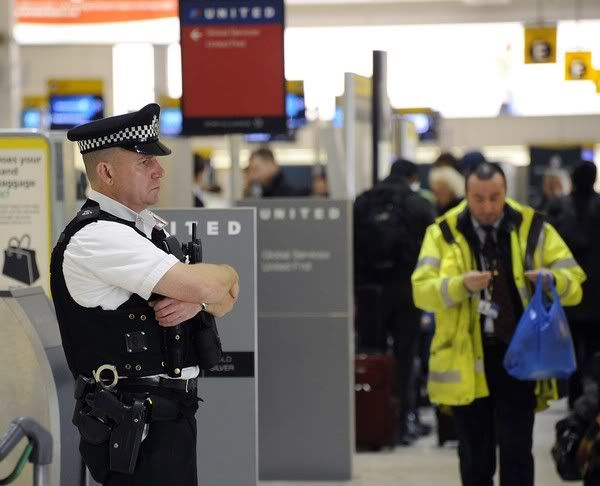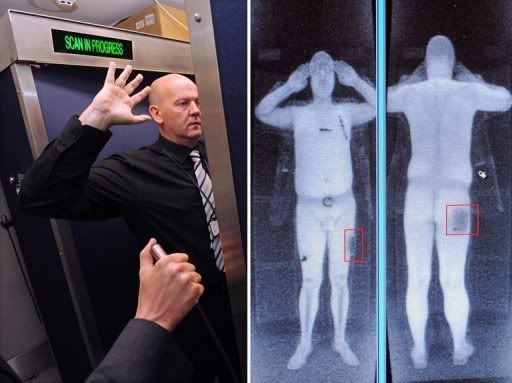
An armed police officer at the busy international London airport stands guard near the counters of a U.S. carrier.
---------
---------
--------
--------
The radiation risk from full-body scanners used to improve airport security is low and unlikely to raise an individual's risk of cancer, U.S. experts said on Wednesday.
Airports in Britain, the Netherlands and Canada have said they plan to use full-body scanners to foil future terror attempts like the Christmas Day attempt to blow up a Detroit-bound flight.
The United States has tested 40 whole-body scanners as part of a pilot program started after the September 11 attacks, and this past October ordered 150 more.
There are two types of machines -- millimeter wavelength imaging and backscatter X-ray scanners. Both are used to see under clothes and identify unusual objects.
Only one -- backscatter X-ray machines -- expose individuals to ionizing radiation such as that used in common medical X-rays.
But the radiation levels are well below the threshold that could be considered a risk to an individual's health, said Dr. James Thrall of the American College of Radiology and chief of radiology at Massachusetts General Hospital in Boston.
"All of the concerns that we have about the medical use of X-rays really don't apply to these devices," Thrall said in a telephone interview.
"The exposure is extremely low and the energy of the X-rays is also very, very low," he said.
"When X-rays are used for medical imaging purposes, they have to be energetic enough to get through the human body. The X-rays used in the backscatter machines in airports have such low energy that they literally bounce off the skin. That is what backscatter implies," Thrall said.
WAVE SCANNERS AROUND THE U.S.
The United States has 40 millimeter wave scanners now in use in 19 U.S. airports. Six machines are used for primary screening at six airports, and 34 machines are used for secondary, or random screening, as an alternative to a pat down at 13 airports.
Millimeter wave scanners beam radio waves over the body to create a three-dimensional image.
Backscatter-type machines, which cost between $150,000 and $180,000, use low-level radiation to create a two-sided image.
Such scanners only become somewhat worrisome when they are used as the primary method of scanning passengers, said David Brenner, director of the Center for Radiological Research at Columbia University Medical Center.
"From an individual's point of view, the risks are going to be small," Brenner said in a phone interview.
"If very large numbers of people would be exposed to a small risk, then you've got a population problem."
As for the actual radiation dose, he said the typical backscatter machines deliver about 0.1 microsevert of radiation. The average chest X-ray, by comparison, delivers 100 microseverts of radiation, and a chest computed tomography or CT scan delivers 10,000 microseverts.
According to the Transportation Security Administration website, the radiation dose from a single scan on a backscatter machine is the equivalent of two minutes of flying on an airplane.
Brenner said that as with medical scans, the benefits of the scan need to outweigh the risks. "If the benefit means we're safer, then that probably outweighs the potential risk," he said.
Full body Scan may break Anti Child porn law.
The government said Tuesday it was working to allay fears that body scanners being introduced at airports would break laws against creating indecent images of children.
Prime Minister Gordon Brown said this week Heathrow and other airports will introduce body scanners, as part of efforts by countries to tighten security following the failed US airliner bomb plot on Christmas Day.
Privacy campaigners told the Guardian that the images created by the machines were so graphic they amounted to "virtual strip searching" and have called for safeguards to protect the privacy of passengers involved.
Terri Dowty, of civil rights group Action On Rights For Children, said the scanners could breach child protection laws, which made it illegal to create an indecent image or a "pseudo-image" of a child.
"They do not have the legal power to use full body scanners in this way," she told the newspaper in comments published Tuesday.
A Department for Transport spokesman said a code of practice was being drawn up for airport staff who will use the scanners.
"We understand the concerns expressed about privacy in relation to the deployment of body scanners," he said.
"It is vital staff are properly trained and we are developing a code of practice to ensure these concerns are properly taken into account.
"Existing safeguards also mean those operating scanners are separated from the device, so unable to see the person to whom the image relates, and these anonymous images are deleted immediately," he added.
Some countries, led by the United States, have announced additional security measures at airports since a Nigerian man was charged with trying to blow up a US-bound jet on December 25.
It was foiled when explosives allegedly sewn into the man's underwear failed to detonate, and passengers jumped on him.
RELATED POST:-







0 comments:
Post a Comment